some games I played in
2020
Persona 3 FES
PlayStation 3
May 06 ~ Oct 16 (The Journey)
May 06 ~ Oct 16 (The Journey)
It's the closest I've come to playing a modern contemporary game, and it's still nearly fifteen years old! Maybe this decade I'll finally see what this Gears of Wars business is all about!
Pal herrDoktorat talked me into this after wanting to expose me to Persona in more ways than reading his and Angevon's lovely fanfic. As much as everyone alternate raves and/or shits upon Persona 4, I feel like I've already played the game with the amount of pop culture osmosis I've been exposed to.
I've read Dok's fanfic (AND YOU SHOULD TOO), I've seen the Hiimdaisy comics, I've scrolled past years of discussion on random social media feeds, I struggled through two episodes of the anime before screaming "get to the new shit already!" This was Dok's personal favourite in the series, and it happened to be the only one available on PSN, so I figured I'd take the dive. I wanted something to surprise me!
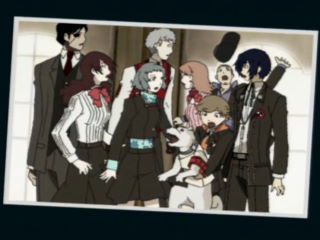
Ordinary teenager Jerry Ramstone (that's his canon name and you can't convince me otherwise) awakens his Persona, a superpowered reflection of their inner self. By day you attend school and manage relationships and responsibilities, and by night you fight crime shadows, beings that attack society during the timeless Dark Hour and reside in the fucked-up tower of Tartarus.
Juggling your daily life in between visits to Tartarus is interesting, and I can see the fun routine in deciding what's a better use of your time -- exploring Social Links and stat boosts, or just pursuing whoever's the most fun to hang out with. In between periodic boss dungeons there's stuff like school exams, sports training and other responsibilities, so it's a nifty world to engage in.
One of my stumbling points with RPGs, particularly non-linear ones, is literally not knowing where to go next. My eternal problem with the first Final Fantasy has been getting lost on the massive overworld, going completely the wrong direction, and by the time I'm on the right track I'm overlevelled to the point that I've erased all the challenge. Exploration can be fun, but in RPGs where the chance of winning or losing is controlled more by numbers than your personal skill, it's the sort of thing that can get dicey either way.
By basing the progression around days on a calendar and limiting your exploration to only a few locations on a list, it streamlines the entire process of exploring and progressing. There's never any fear of "where do I go next?" because the answer is always "go to bed, idiot."
This means the concern is rarely about missing vital items in a dungeon (it's all randomly generated anyway!), but wondering if you used each day to their full potential. Are there people worth talking to in this area? What about on certain hours or days? It's a different kind of exploration, arguably more time-management than anything, that's not without its own foibles (i literally never knew Fuuka had a social link until a week before endgame...!), but it strips away the problem of becoming daunted by such a huge, sprawling world.
By splitting the day into afternoon and evening activities, it makes you choose your priorities -- do I pursue social links? Do I stick with one story or do I diversify my portfolio? Or should I grind for stats to unlock new social links? It's a trifle aggravating knowing how little gets done during the day, but juggling the needs of yourself and your peers is a neat challenge. Social links earn experience points when fusing new monsters, so sometimes it's worth slogging through some boring asshole's story arc just to power up a beefy monster.
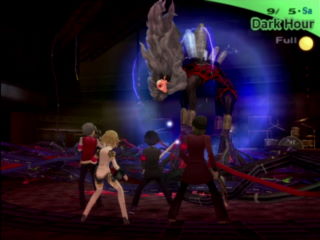
It's when Tartarus enters the mix that this flow gets disrupted. A breezy week can fly in ten minutes if you stick to your charted course, but since there's no limit to how long you explore during the Dark Hour, you can spend multiple real-time hours in there, exploring dungeons, tackling requests, fusing Personas... and during that time it's nothing but raw gameplay.
Despite being surrounded by your teammates and fellow students, there's nothing for them to say but scripted lines relating to battle or their condition. It's hard not to feel a dissonance when I can spend hours upon hours grinding in a single night, everyone bailing each other out of sticky situations... and by the time it's morning Junpei's still a jackass stuck in his inferiority complex arc. To expect relationships to develop over the course of busywork is demanding a lot from a game that's already got an in-game year's worth of story to fill, but even just idle banter would've helped. Pineapple Smash Crew did it! It was nothing but quoting catchphrases from British sitcoms, but it made an impression!
One thing I appreciate is, although the player character is given leadership during field missions, the story largely unfolds without his input. The characters resolve personal crises and come to conclusions on their own or amongst themselves; you the player are privy to these scenes, but your character isn't, simply waking up the next day to realise, eyyy, someone's conquered their personal demons or whatever. To see the cast come out of their respective shells and show great strength is satisfying to see, without it coming down to picking premade responses. Save that for contrived social links!
For the purpose of story and pacing, exploring Tartarus is perhaps a bit of a drag, but I personally quite enjoyed it. I never ever hear anyone discuss the actual dungeon stuff in Persona games (probably because waifu wars dominate the discussions, spare us all), but the randomised floors are neat. It took me a while to find a good flow to exploring them, but there was something zen-like to spending an hour each evening roaming the floors, leveling up my party and acquiring new Personas to fuse.
While I grouch about the lack of meaningful interactions during them, they were perfect for zoning out and listening to a podcast for the duration. It made for a charming evening routine. I might've overdid it on grinding, mind -- in the early game some bosses are roadblocks because you simply don't have the resources at your disposal, be it elemental weaknesses, multi-purpose Personas or even just an excess of items. Come mid-game though, I never had too much difficulty with any of the boss fights.
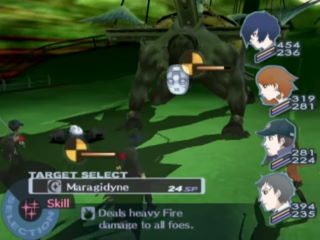
Speaking of fights... hey, the battle system is compelling! So many articles simply equated it to Pokémon, but it feels so much more dynamic than that. What grabbed me the most was its way of weaponising turns, so to speak. Striking a target's weakness will knock them out for that turn unless they're attacked again, as will landing a critical hit. For the player, this means stumbling all foes allows you to perform an all-out attack, a free action that does fat damage; when AI partners achieve it you might as well let them, but for yourself you may want to use that window of opportunity to cast buffs and refresh yourselves.
Of course, foes hitting your weaknesses or landing crits stinks, and you want to optimise your party and current Persona so you're not susceptible. Most early bosses I had to do a doomed test run or two just to learn its moveset and weaknesses, and then restructure accordingly.
Likewise, stuff like Final Fantasy always struggled to make physical weapons seem exciting compared to magic -- magic's got a swish animated vignette attached to it, while attacking is just a static sprite waggling above your head. It's very possible it's a standard of JRPGs -- do I look like I've been paying attention? -- but Persona 3 makes both elemental magic and physical attacks have their own uses.
Weapons have a greater chance of landing multiple blows or critical hits, and every crit is a knockdown. When you don't have a monster's elemental weakness, sometimes eschewing powerful magic for just laying on blows can make a difference, with the hope of a crit to ground them and paving the way for an all-out attack. It sounds basic, but when a turn-based RPG makes manipulating turns such a key component, I find myself way more invested!
A feature I've heard people grumble about but I personally enjoyed was the lack of control over your party members. Everyone else will act on their own accord, hitting weaknesses once they're clued in, healing themselves or others in dire straits, or just sitting out a turn for lack of anything meaningful to contribute. It took me an embarrassing amount of time before I even discovered the tactics command, allowing you to issue protocols on what foes to target, what kind of attacks to land, or to simply sit back and support the team.
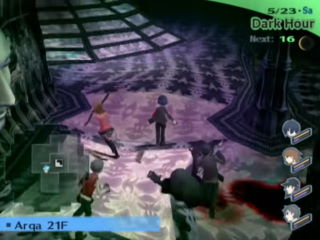
It can be aggravating when party members would rather idle when they could be healing (HEAL ME!!!! IT'S GAME OVER WHEN I DIE!!!!), but it made me far more engaged in the mechanics, and better acquainted me with each member's perks and traits. In some fights it was more beneficial for me to sit back and keep everyone else healed, as they were better equipped to deal damage it than I was at times.
Lining up comboes that others could maximise with their own toolset felt very satisfying, especially knowing they themselves made the decision, rather than me having to manually command each and every action. If someone thinks it's worth buffing, they must know what's up! Partially automating the battle process is such a boon when countless random battles not worth running from were what reduced my brain to mush in most other RPGs. And these are supposed to be thinking games, you say...!?
By the mid-game there's stacks of resources at your disposal -- no shortage of items from repeat dungeon sweeps or Elizabeth's requests, boosted EXP via social links -- but no matter how beefy you may seem, one wrong move still has dire consequences. Landing a surprise attack or getting struck first on the overworld can be the difference between success and a game over.
Even foes you've blitzed countless times before can suddenly wipe out your whole party if you don't take them seriously. Having the wrong Persona equipped can be enough to get demolished by foes who know your weakness, which resulted in some extremely salty game overs... but it felt good to be reminded to never take things for granted and to always play smart. I only came to that conclusion after ragequitting and stomping off first, mind, but better dying with a lesson learnt than dying to badly designed bullshit.
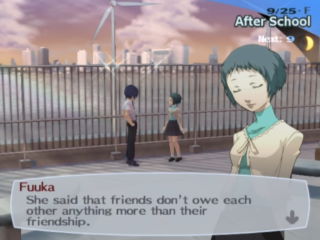
The story that drives the action is pretty boilerplate for most of the game, just enough to give you an objective and get some insight into the other characters. Getting acquainted with your partners and the community around you is the real deal... though I perhaps took for granted how much of it is anime bullshit. Nobody told me these are games are populated with teenagers! I do not want to hang out with your hot-for-teacher ass, Kenji, and you need to grow a personality, Kaz. If you're not a cute girl then get the fuck out of my face.
That was admittedly my struggling point early on -- lack of engagement! Gimme some meaningful interactions! While the social links are all interesting, it takes a while and some stat-grinding before the more interesting ones become available, and you go a shocking length of the game before you actually get to hang out with your fellow teammates. What's Yukari up to? I've no idea, I just gotta wait 'til the next plot event in however many weeks...!
Come the Autumn seasons I became truly invested in the game, thanks to new members joining with dark histories and bad blood, and the repercussions of their actions beginning to effect the world around them. I didn't see some of them as much as I would've liked (though it's possible I missed optional scenes or what-have-you), and I think that's either my beef with the storytelling or my failure at parsing stories in video games.
It felt like I was expected to step into the shoes of the player character, and really view all these events through his eyes: what it's like to now be living with middle-schooler Ken or having a dog and a robot join the team. To extrapolate things more than simply reading whatever text is dished out on-screen. I struggled to parse the main character as a character and not just an avatar of my limited input as a player... but that's a ludonarrative debate to have with someone more qualified than myself.
The final boss took a sudden swerve for the obscenely difficult, forcing me to reload an old save to not just beef up my party, but spend five hours coming to terms with the fusion system. A trifle unexpected and perhaps slightly unwarranted, but it was nice to see a proper challenge after all this time...! I was glad to beat it -- it's a game I wanted to see through to the end. It was nice to see what all the fuss was about.
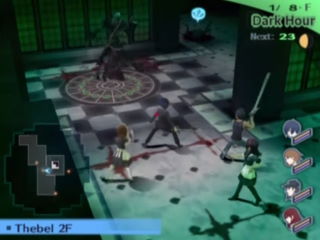
That, and keeping Dok informed of my progress was a big part of it. I joked about us forming a "video game book club", and this is the closest we've come to that. Being able to discuss plot developments or character actions has me far more engaged in the goings-on than I would if I were playing it on my lonesome. Discussing the characters arcs of Junpei, Shinjiro and Ken... it helped give a fuller picture than what I would've observed from only my own preconceived notions. Is it better that Shinjiro dies a hero, or would it have been more compelling to see him live to address and unravel the mess he'd gotten himself into?
When I play a game it's usually the moment-to-moment stuff that I'm invested in most, hence why Undertale made such an impression. Persona 3's far, far more long-form and way more large-scale, as the day-to-day goings-on are mostly your decision, individual plot threads with no direct bearing on the story beyond the themes of humanity and understanding. Like I've said, there's a lotta distractions and so many ways to banjax the pacing that it's easy to lose sight of the big picture.
It was a chance to engage with the game even when I wasn't playing, to hear a different point of view from what I took from it. I love picking apart and dissecting game design (if these obsessively wordy articles about bloody Mario Party Advance haven't been a clue), but engaging with stories and themes isn't exactly my strong suit.
To read into characters' motivations and actions and get a clearer view of the game's worldview was very satisfying, and making it an ongoing discussion helped me make time for the game rather than let it fall by the wayside. If I'm going to drop a hundred-plus hours into something, I want to mine some good earnest debate out of it, gosh darn it!
Er, yes, my final post-credits save file clocked in at 95 hours, but I'm certain there were at least another 30 hours on top counting all my game overs and redoes. It's the longest I've sunk into a game since my Nintendo 64 days, I'm pretty sure. Steam tells me I dropped fifty hours into Shovel Knight across its four campaigns, but that's another kettle of fish...!
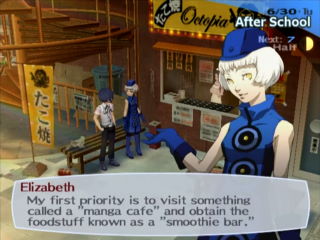
Was I glad to have played the game? Yes, very. It was good to have a reminder that RPGs can be good, actually. The writing perhaps wasn't as mind-blowing as people hyped it up to be (no joke, I was spoilt by making Dok's fanfic my introduction to Persona. it's written so much better than the canon...!), but it felt good to have a story to get invested in, and more importantly a battle system that felt rewarding to master rather than just mashing through commands brainlessly.
Will I play another Persona game? That... remains to be seen. I really am in no rush to play P4, possibly out of spite. If I were I'd probably explore spinoffs first, or even the mainline Shin Megami Tensei games, but truthfully, I think one hundred-hour RPG is enough to sate me for a while.
Will I look for other RPGs to play? The game was a reminder that good, engaging mechanics can make such a difference to the grind, and knowing how much love Dok holds for the genre, I feel like I'm missing out. That said, the back-and-forth of discussion was half the appeal. To play an RPG on my own with no one to discuss it with just sounds just a little bit miserable, honestly. Whether or not this is a silent plea for people to request RPGs just so we have a mutual topic of conversation... well, there's only one way to find out!
Anyway! Persona 3 was good. Wasn't entirely satisfied with the ending, but a hundred-plus hours raises expectations a bit, don't it. I still have the after-story The Answer to play, but knowing it lacks the social links and EXP bonuses from fusions is a bit of a killjoy. Glad to experience it, would say I had a good time with it (on average!), and whether you take that as a recommendation is down to your personal tastes and also how much you read into my duff opinions.
Mortal Kombat: Defenders of the Realm
Apr 24 ~ May 04
Apr 24 ~ May 04
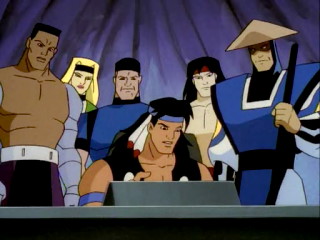
Dok and I were watching Sense8 throughout May, a frightfully good show that certainly scratched my quarantine-induced itch for sightseeing... but we needed something to let our brains cool off a little, and this was what we chose. Who knew this would become our new comfort food? A completely brainless yet strangely compelling watch that neither of us expected to get this invested in.
Seemingly set after the events of Mortal Kombat Annihilation, the Kombat Krew (not an official moniker but by god who's gonna stop me) hang out in their subterranean headquarters and respond to portals from Outworld appearing across the globe, fending off potential invaders. What invariably ensues is eighteen minutes of completely interchangeable action sequences, with maybe three minutes of plot, tops. I did say it was brainless fluff.
It's got eight heroes to juggle -- the cast of Annihilation plus Nightwolf, Sub-Zero and Stryker added to the ranks -- meaning there's enough on its plate without needing a consistent baddie. Although each episode is typically a threat-of-the-week, the thrust of their story is less about a quest to defeat some grand villain, but instead focuses more on the individual heroes' plights and struggles.
It's an interesting way of doing things, and plays into the franchise's ethos of world-building, which drip-fed nuggets of information via the character bios, endings, or what little plot the games presented to you. Despite toning down the violence and retconning deaths that took place in the films, it otherwise tries to build upon it, painting a greater picture of Outworld and the forces drawn into its wars.
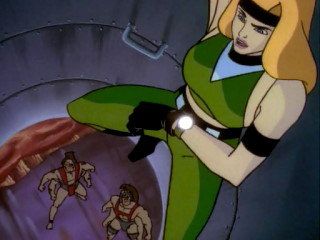
Sonya's probably the star of the show, honestly. She's punchy and bursting with moxy, a real mover and shaker by virtue of running head-first into combat or drawing idiotic conclusions the instant she thinks of something. After her more reserved role in the movies you could argue it's character assassination, but it gives her a more vivid dynamic, always pushing for action or butting heads with whoever she's partnered with. The fact she's constantly interrupting any talk of strategy to scream "Kombat time!" is a bonus.
Likewise, Raiden is perhaps the best he's ever been: he enters every scene sassing everyone, acting like a belaboured babysitter who's got better stuff he could be doing. He's criminally snarky and can be a stone cold bitch when he wants, but there's rare depths of kindness and humanity to him. He's often left cleaning up messes the others can't, but he's not without a few fuck-ups of his own. If he didn't choose to be their mentor he could just as easily be a bomb-ass villain.
Liu Kang and Nightwolf feel like they swap out playing the 'kid' role of the show; Nightwolf spends most of the time at base, while Liu Kang's one spotlight episode focuses on how, by becoming Mortal Kombat champion, he's now immortal? It's a weird angle to run with, one that gives him some keen kinship with Kitana, but he's otherwise there just to crack wise with Jax.
After being the impulsive jerkass in the movie, Jax swaps roles with Sonya as the more level-headed one... and for some reason, a lot of his dialogue makes him ready like a sassy gay best friend. Honestly, I'm here for it. His focal episodes are perhaps some of the strangest, but as far as I'm concerned he brings a lot to the table just by being the most 'human' of the bunch.
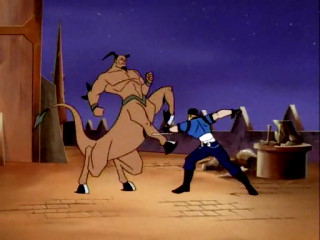
After that, the roster begins to wane a bit. Stryker sucks. He's the one hero to not sneak a cameo in the movies, and he's barely got a personality. You could argue the cast needs a stringent by-the-book type to balance things out, but he's got no merit whatsoever. They somehow got Ron Perlman to voice him, just one of the many voice acting gigs where he has the privilege of voicing the shittiest character.
Sub-Zero and Kitana are the mysterious loners of the group, and don't seem to contribute a whole lot despite their alleged prevalence in the lore. You'd think Kitana should have so much going for her: as the princess of her realm, she'd be the best candidate for leader if Raiden weren't around. And after losing her kingdom and being enslaved to Shao Kahn, she should have the strongest motivation for fighting evil... but her schtick of talking in cryptic bullshit makes it real easy to tune her out, it seems.
It's a good thing the heroes have the responsibility of telling the story, because the running theme throughout the series is the baddies are kind of lousy. While it's interesting to focus exclusively on the heroes' efforts, without the dual focus seen in fare like Street Fighter or Transformers, it leaves you wanting for good villains to get invested in. Most of the foes are relics of their respective pasts; Sub-Zero settles the score with Scorpion, Kitana avenges her murdered mentor...
... but of them all, Kano's the only one I gave a shit about because he's such a cackling lout. He's the one baddie to do bad things to people we know! Shao Kahn ravaged Outworld, but we don't actually see any of that! Shang Tsung killed Liu Kang's brother in the films, but it goes completely unmentioned this time. You'd think Liu would have a bone to pick with him about that. Honestly, what we need is Ermac and Rain as the Scratch and Grounder to Shao Kahn's Robotnik.
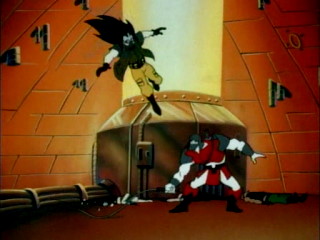
This is a lot of words dedicated to a series I've already described as little more than fist-shaped packing peanuts. A lot of it is by-the-numbers action series tropes: repeated statements of "we make a good team, don't we" with shockingly little to back it up.
Yet for all its drawn-out fight scenes and incessant techno music, there are times when it tries its darnedest to have a message or tell a good story, at least by the standards of a Saturday morning cartoon. A lot of it boils down to "my unresolved backstory makes me sad", but sometimes how that's handled is compelling enough, at least by its lowered standards.
The episode where Jax leaves the team, as horrendously contrived as it is on so many fronts, does paint an earnest picture of these ordinary people worn thin by their heady duties. Falling for the first thing that feels like love must be a breath of fresh air when all you do is fight eight hundred ninjas every day. The way it establishes this plot raises a million dumb questions (there's a functioning civilisation out there? Jax has family? the kombat base gets mail?!), but darn it, it's neat to see the faintest whiff of gravitas in a kids show.
I've an idle fascination with the world of Mortal Kombat, or at least its various attempts to adapt it into actual storytelling media. Trying to streamline the huge cast and its scattered lore into something coherent and digestible... rarely turns out that way, but I always respect the hustle. Without the allure of digitised violence, what is there to draw people in? Because when you're not beating up dudes there's a whole lotta crappy legacies and orientalism that's tough to give a shit about.
I love Mortal Kombat's attempts to be kid-friendly. I mean, it should work, right? It's got a great foundation to work with, and I unironically love the cartoon's art style. It's slick and smooth, very much aping what made the DC animated universe so distinctive -- just without the good animation to back it up.
It's got elements that feel tailor-made for a tie-in toyline, like the inexplicable fighter jets that serve only to pad out episodes with limited animation, and it breaks my heart there never was one. Please, before I die, give me a G.I. Joe-ified Mortal Kombat. Show me Sektor with toyetic karate chop action, driving a tank shaped like his face.
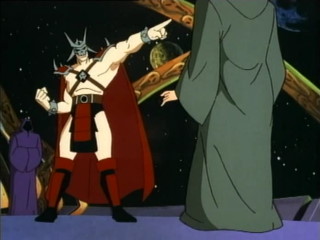
Watching the series was a trip. I'd be hesitant to call it good, but by golly, was it entertaining, exactly the kind of thought-free entertainment I needed after a long day. It's a bit of a weird show compared to other kids fare or video game adaptations, with no side-characters, properly established world, or even any tangible forward motion to its story. Its 'character study' approach gives it a different identity than the likes of Street Fighter and Mega Man, for better or for worse.
There's a lot to respect about it, especially with its story bible floating around online to spell out what it was shooting for... and yet there's so much I feel it could've done differently to make a stronger product. Still, what a ride! This might be my favourite Mortal Kombat media now, just in case anyone wanted to know what a terrible MK fan I am.
The Simpsons: Night of the Living Treehouse of Horror
Game Boy Color
May
May
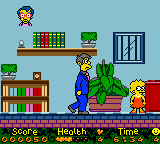
I was ripping the sprites from this while on an inexplicable Simpsons kick. I didn't exactly sit down and play the game, per se, but I saw enough of it while cheating and hacking my way through that I figure I can extrapolate on feelings I had when I foolishly played it years ago.
Credit where it's due, it's not a completely brainless "licensed platformer" archetype. It's not a left-to-right hop-'n'-bop like so many attempts before it. It's instead more exploration-driven, giving you large, open landscapes to investigate as you hunt down macguffins to open new areas and complete the stage.
The first stage is perhaps the epitome of this, as Bart has to gather keys to unlock parts of the house, as well as fuses to power the lights, otherwise rooms in darkness will be occupied by invincible killer brooms. Exploring the Simpsons' house from a 2D side-on perspective is perhaps a bit jarring when one is so familiar with how it flows based on the show, but using domestic settings in video games is always strangely appealing.
It's a pity the execution is just so bleugh. The game's speed is unpleasantly sluggish, not just in its framerate but in how the characters move, with big windups before and after very jump, a nuisance when contending with enemies who've got no such hitches in their movement. While the sprites are big and well-animated, there's so little visibility to work with, making the likes of robot-Homer's mission a nightmare as you explore a labyrinth of nigh-identical ladders and hallways. The camera has to whip around madly every time you turn around, and with the low framerate it gets positively nauseating very quickly.
Although explorative, each stage is played against a time limit, and dying by any means will force you to redo the entire stage, keys and all. This is almost acceptable in smaller stages like King Homer or fly-Maggie's, but when every other stage is incredibly sprawling and fussy to explore, it's a bit of a kick in the teeth. It really doesn't help that the music is incredibly repetitive and grating as all hell... or that it restarts every time you enter a new room. You get real acquainted with those first few droning notes, lemme tell ya.
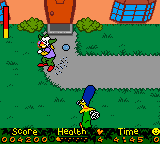
About the only halfway tolerable stage is Marge's, which is a simple top-down shooter as you march through zombie-infested Springfield. It helps that by sticking to the corners you can avoid most of the enemies, and the game only stops you once you reach a boss. It feels more 'hands-on' than the comparatively passive approach all the other stages employ, and while it's by no means a stunner -- it's still hampered by low visibility, limited movement, and crummy attack options -- it's more immediately enjoyable than the other guff.
When I first bought the game it was a toss-up between this or Mario Kart: Super Circuit. That probably says a lot about me, don't it? Super Circuit might not have been a terribly exciting entry in the long run, but it's serviceable for what it is. Yet I'd sooner try a game that's almost guaranteed to be bad (IT'S A SIMPSONS GAME!!), if just to see what it attempts. There's maybe some ideas in there if you squint, and it would be nice to see a handheld Simpsons game that was halfway decent... but I should quit with the thought exercises and just play a good game for once in my life.
Mortal Kombat
May 9
May 9

Another watch with Dok, and a film I'd already subjected myself to two times in as many weeks just ten months prior. I loathed it once, then subjected a friend to it just to make them suffer, and now Dok suggested it to fill a lazy afternoon. Will a third watch suddenly change my tune...?
As a youngster it was hailed among friends because "IT'S JUST LIKE THE GAMES!!!", easily more accurate to the source material then the likes of the Mario or Street Fighter. I don't think any of us actually gave a crap about Mortal Kombat, so this was kind of a pointless thing to boast about, but it's shocking the amount of hills a ten year old will die on if given the opportunity.
I just find the film shockingly dry. Its plot is incredibly thin, giving the three stars only the barest reasoning for entering the tournament, and it feels like every subsequent plot beat is pulled out of its ass. About the only character whose quest we're actively engaged in is Sonya's, who's out to kill Kano and avenge her fallen partner.
Kano is the most 'human' villain, a swaggering, boasting lout who gets three scenes to himself, tops. He makes a mean presence in those three scenes, though! Then he gets his neck snapped in a crap fight scene and Sonya has nothing left to do, so Shang Tsung turns her into a damsel in distress. It's not great.
The film's basically a parade of fight scenes -- what more do you want from a fighting game adaptation? -- but there's so little variation to them. Everything's one-on-one! Everything's fisticuffs! There's no physicality to the environments, barely using props or elevations to their advantage in a creative way... hell, most of the fights barely even have an environment, they just take place in what might as well be a flat arena.
The only good fights: the scrap with the hooded grunts is energising, partly because it's one of the few multi-man melees, and for its somewhat unwarranted use of the iconic Mortal Kombat rave theme. Scorpion vs. Johnny Cage is decent once they warp to hell, because they actually acknowledge the bomb-ass environment as something to be utilised for dumb flips. And of course, the completely inexplicable fight between Reptile and Liu Kang is the kick in the teeth the film sorely needs: fast-paced, balls to the wall, and with some thumping techno backing it.

... unfortunately, by that point you're over 70 minutes into the film and it's running out of steam. So many of the fights until this point are short, unexciting or otherwise make no impact. The plot is now Shang Tsung playing hide-and-seek with the heroes in Outworld, and they interrupt it with a completely out-of-the-blue fight sequence. Where was this fight fifty minutes ago?! And when they find Shang Tsung they interrupt it again when he summons a bunch of souls to fight Liu Kang! I don't care if it's homaging the arcade game's endurance matches, just get to the final boss already!
The film just lacks the moment-to-moment buzz that other '90s video game movies boast. There's a few good character interactions and amusing moments, but most of the time it's just knee-deep in prophecy bollocks. The actors for Liu Kang and Shang Tsung are terrific, giving both characters more oomph than they had in the games of the era, but there's barely any script to sink their teeth into.
Hell, there's no blood or gore! Scorpion dies burning, bleeding and exploding (but he's a skeleton so it's okay), and Shang Tsung gets a drop of blood on his lip. That's your lot! Goro, impressive as he is for an animatronic, sets up multiple instances where you expect him to crush a dude's head or rip them in half, and he always sets up for disappointment. To be fair, I do respect that -- MK's cartoonish level of violence is acceptable with silly digitised sprites, but in any other format it's a bit much to handle, personally. Better to let the action speak for itself than cloud it with messy amputations or whatever.
To its credit, hats off to Paul W.S. Anderson for making this his first film production. Like so many movies of the era, it goes absolutely ham on set design, and it's my favourite part of the movie: the exotic locales in Liu Kang's temple and the tournament island are beautiful, and the otherworldly locations they visit like the temple and more are filled with outstanding statues and detail.
The film loves zooming matte shots, and while they might be cheesy nowadays, they do wonders for painting the place as bigger and denser than you could ever imagine -- this ain't just behind some trees, this is an entire freakin' complex! It really sells the island as truly mysterious, with more going on than you could ever know. Forget fighting games, I want a Myst clone set on the island.

At the end of the day, it's just a martial arts movie. I struggle to call it anything more than that. By no means a slam on the genre, but it not only fails to hold a candle to most other films of its kind (it probably didn't help I watched Enter the Dragon the week before i watched this last year), but it feels a lot less ambitious than its video game competitors.
Super Mario Bros. was a cyberpunk family adventure movie. Street Fighter was a campy espionage thriller, equal parts Die Hard, James Bond and cocaine. Those films are bursting at the seams with characters and plot threads, and even if you can't keep up, there's always something new and outlandish to look forward to, be it ridiculous setpieces or corny dialogue.
... and then Mortal Kombat is just a martial arts movie.
I will admit I think I have misplaced nostalgia for those screwball nothing-like-the-source adaptations like Street Fighter. To see something that's so solidified over the years of new releases and more lavish tie-ins twisted into something nigh-unrecognisable is hella compelling! What I'd give for more Street Fighter media based on the movie! What's Steven E. DeSouza doing these days, and what's his commission rates? If there's one person powerful enough to write a sequel...!
But at the same time, Dok rightfully said that he was disappointed in that movie for the same reason. If you liked the Street Fighter games in the '90s, you were shit out of luck if you wanted more like it, as the movie, cartoon and comics all had their own bizarre takes, warping its pre-established characters and plot threads. Mortal Kombat has its own idiosyncrasies between its spin-offs, but at least the plot, the theme, the characters are all roughly the same. I mean, what is there to mess up...?
Long story short: surprise, watching the film with someone who enjoys it rubbed off on me a little! Less of a surprise: I don't want to rewatch this movie anytime soon!
Pokémon: Detective Pikachu
May 11
May 11
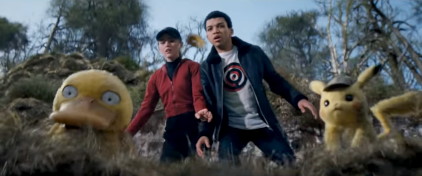
I caught this last year in cinemas with dad, who was way more eager to see it than I was. To see the world of Pokémon reimagined in such a way on the big screen was incredible, and to paint it as an "in-universe" story rather than just another trainer quest was a fun way of introducing all manner of audiences to the world.
The mystery wasn't exactly grandiose, but the setpieces and characters along the way were a trip, and even as a long-relapsed Poké-nerd, it was cute seeing all the little references and homages through the world, be it world building on flyers or setdressing or what-have-you. We were both plenty satisfied by it!
Then I watched it this year with Dok... and it didn't make quite the same splash. In fact, this time around my takeaway was: who is this for?
What a strange and slightly disgusting way of interpreting Pokémon. The bizarre sense of humour, the strange dark turns... it's such a weird way of adapting this kids franchise, though that's probably why it seemed so appealing -- this ain't your kids' anime! This is Hollywood, baby!
The world is kind of dark and grungy and just kind of unappealing. For a city where Pokémon supposedly cohabitate with humans, it struggled to convey the synergy it really wanted to show. Everything is so hands-off (understandably, because that shit's hard to CGI) but it feels like for a world of living, breathing, huggable monsters, everyone's always at arms length from them. And if even this idyllic city is this boring, how dull must the rest of the world be?
Ryan Reynolds is adequate as Pikachu, though maybe it's because it's the first time I've rewatched one of his films, but I found myself a bit tired of his schtick. It rarely feels like Pikachu is a character so much as a vehicle for catty adlibs. He's smarmy and has no qualms about his only human partner possibly getting mauled by monkeys early on.
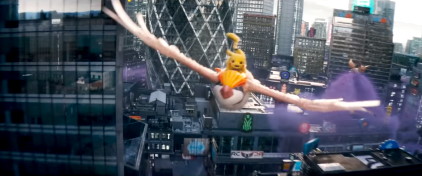
And then there's the weirdass villain who's disabled so he wants to put his mind inside Mewtwo and also make the whole world into Pokémon? ... is this a bad thing now? I probably hang in too many circles where people would love to be a Dragonite, mind, but it seemed such a strange way of treating the property.
They want you to like the monsters (they wouldn't make oceans of merch if that weren't the intent!), but to become a Jigglypuff? To be robbed of your lanky anatomy and need to participate in capitalist society? A fate worse than death, apparently. I know some stories talk about "being transformed into a dog sucks, actually", but these are dogs with fuckin' magical powers. Live a little! It makes for a visually-impressive climax, I guess, but at what cost?
The film's got a lopsided sense of fantasy and whimsy. For every magical image like finding a Cubone in the field behind your house, there's the acknowledgment that it's just the same world we live in now. The main character works in insurance, for cryin' out loud! His partner writes listicles! What must the world of insurance be like where man's best friend are capable of levelling a building if they get frisky? Who knows and who cares, apparently! It's only there to paint our hero as living a boring, menial existence, but nobody else looks to be living the good life either.
Between this and the Sonic the Hedgehog movie, it's strange to see film adaptations of kids media... have no kids in them. Do modern adolescents prefer to project onto listless adults? Are cinema-goers that soured on child actors? To explore this world as a wide-eyed youngster feels like it'd give the film a more vivid edge, and provide a better contrast between the schoolkid's image of Pokémon versus the grungy underworld the clues lead them to. But it could just as easily be a bad move, so who knows.
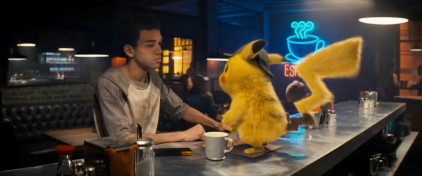
On that note, it's strange watching this after having seen Sonic, which I took for granted how being a perfectly adequate kids movie was just what the doctor ordered. It's got its foibles, but it's perfectly satisfactory and got something for all audiences. This movie feels like it's made for the adult or semi-ironic Pokémon fans... which is fair enough, I suppose. There's no shortage of straitlaced Pokémon media out there anyway, so to do something off-kilter is no doubt what gave the project momentum.
I expect my opinion to pinball every time I rewatch this movie; I just wish I wrote down my feelings on the first go-around! I did watch it on a computer monitor, while talking on Twitter, while making dinner... so it's all too likely that was a less-than-ideal viewing experience. What an impressive and original way of adapting such a famous franchise, and I mean that in both the best and worst possible ways.
Mega Man 11
PC (Steam)
May 18 ~ 22
May 18 ~ 22
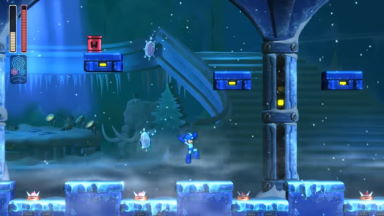
Mega Man finally goes next-freakin'-gen! He hasn't done that since the bloody PS1 era!!! MM9 and 10 were good, but the blue bomber practically sat out everything after the PS2 era, though not for lack of trying. There's already been reams of spiritual successors and games clearly inspired by it in the interim, indie darlings like Shovel Knight and undeserved punching bags like Mighty No.9.
I won't lie that I found myself in the same line of thinking that I had when New Super Mario Bros. came out: It's been nearly a decade since the last instalment... imagine how much bigger and better it's going to be with the leaps in design and technology! All the weird design choices they experimented with in Mega Mans 6 through 8 can finally be done right!
Mega Man 11's just back to basics with added 3D graphics, for all intents and purposes. It's exactly what you'd expect from a Mega Man. It's still a side-on 2D platformer, it's still got 8 robot masters to beat, and four fortress stages at the end. There's a shop where you can buy upgrades, some of them familiar staples, some of them new quality of life features. I will admit I was hoping for something more, but I'll also fess up that my expectations were pretty stupid.
The closest it's got to new features is the Double Gear system, allowing you to slow down time or power up your weapon (including the master weapons) so long as it doesn't overheat. A lot of challenges are built around the Speed Gear; in addition to zippy attacks and boss patterns, numerous stages feature auto-scrolling death traps that highly encourage you slow the game down and plot your next move carefully. The Power Gear is a bit fiddly, but it boosts the power and range of your weapons that, when sussed out, is very useful; Tundra Man's column of ice becomes a full-screen bomb, and applying that power-up to a boss's weakness can demolish them in just a few strikes.
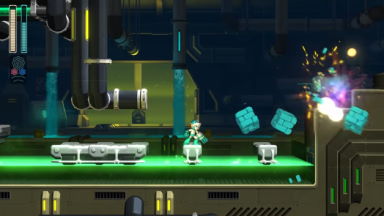
On Normal mode at least, the Double Gear is an extremely limited crutch at best; using it to its full effect with its tiny energy metre and long recharge time is very tough, especially when the game throws proper bullshit challenges at you. In addition to the usual surprise enemies that knock you into pits, the race-against-death-traps often give you little warning they're coming, with next to no room for error. Please do yourself a favour and play your first run-through on Casual. Starting the game on Normal did not do my mood any favours. (do you know how long it's been since i got 7 game overs in a single sitting?)
The series makes the jump to 3D pretty smoothly. Mega Man's jumping is perhaps a little off compared to the eight NES-style instalments before it, and the very minor perspective on platforms makes some jumps a little deceiving... but on the whole, it plays well. It's exactly what you'd expect from a modern Mega Man. All his staple moves are back, including some quality-of-life features like mapping Rush functions or even the slide to buttons. You can finally use the right stick to quick-select master weapons, and click it to reset to buster; it's a bit hectic to use when you're scrambling for answers, but it results in far less problems than scrolling through them with the shoulder buttons.
Despite my grief at enduring so many game overs, the difficulty can be tweaked in a number of ways. Alongside the four difficulty settings, the in-game shop offers not just extra lives and E-Tanks for super cheap, but also a variety of optional upgrades that can be ticked on or off any time in the pause menu: auto-charging your buster, increasing the length of the Double Gear gauge, etc. Casual difficulty is a blessing if just for including far more checkpoints; having to redo huge chunks of stage in Normal because you died at the first of three mid-bosses is a prime way to make me hate things.
Playing it a second time did make me appreciate the game's design. Finding uses for the Power Gear'd master weapons, little shortcuts to bypass sections be it with Rush Jet, or finding a stage enemy's unexpected weakness. Even how interactive enemies can be with one another is neat; the bomb dudes in Blast Man's stage serving as weapons, or the destructive liquid in Acid Man's stage. It's a game that feels especially tailored for replay, where experimenting and optimising your route is the bigger reward than finding secrets or what-have-you.
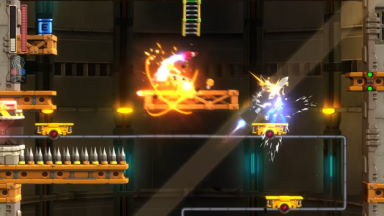
It's admittedly hard not to wish there was something more, though, or at least refined. The game finally has proper voice acting (Mega Man 8 didn't make a good impression did it), and I found it more distracting than anything. The robot masters are hard to hear over the music, but Mega Man's death scream is so obnoxious I'd no incentive to ever take it off mute.
The cutscenes are still steeped in the old-fashioned sprites-standing-in-a-line presentation, and while the story is the first to properly explore Wily and Light's relationship, one can't help but wish for something involving the robot dudes we're more invested in. Nice to give the docs a bit of depth after all this time, at least...!
I haven't explored the Challenge Menu much because it feels so tucked away from the rest of the game. Mega Man 9 and 10 felt like they proudly boasted its new challenges and DLC content, which included brand new bosses and levels and felt truly exciting for it -- and extra playable characters, to boot! MM11, meanwhile, is mostly limited-resource challenges or time attacks, and the couple of mini-games I tried were... not great. Especially when the time it took to load the leaderboards and retry was about as long as some of my attempts. Optimise your load times, people!
I think I'm unfairly biased towards the 8-bit titles. Every time it's stepped beyond that it's been hard to come to grips with their new quirks and idiosyncrasies, which is perhaps why MM9 made such a splash. All it had to do was fine-tune Mega Man into the best it could be! All staple themes and weapons we've seen before, but refined to the most inventive challenges and multipurpose use, with a flow to its stages that felt spot-on. A bit brutal to a first-timer or someone learning the ropes again, but it felt challenging and engaging without entering ROM hack territory. MM10 kind of hurt perception by just doing the same old trick again. It's fine, but at that point you wanted something a little more fresh.
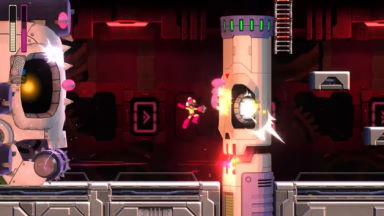
Mega Man 11 is also fine. It's good and competent, but even with its new graphics and extra bells and whistles, I didn't feel the same sense of invigoration as I did from MM9. Some setpieces are good but there's some duff screens too. Some weapons are excellent and some just fill a gap. The Wily fortress is exactly how you'd expect it to be, complete with Yellow Devil retread, boss rush, skull mech, the works.
But maybe the quality of life stuff makes up for it. You can save or visit the shop in between fortress stages, and a completed save file lets you revisit them all. It's a darn sight more generous than MM9 was, if you ignore the death trap auto-scrollers. It just tends to feel a bit one-and-done if you were hoping for more than just the bare essentials of a Mega Man game. Better that than promising the heavens, I suppose.
It's simply another serving of Mega Man, and how much you appreciate that depends on how much the clones and inspired-bys scratched an itch. Having seen how Mighty No. 9 handled weapons that drastically changed how you approached challenges, or Shovel Knight's whole new approach to 'boss' levels and 'bonus' stages... there's a part of me that wishes Mega Man 11 did more than just slap on a new coat of paint, and really went out there and reinvented itself. But there's merit in simply having another new Mega Man game with no frills attached. Would've been nice if people reciprocated its release after years of banging their fists on tables for it, mind. People were screaming their lungs out in demand, and I still barely hear any discussion of it...!
Power Rangers In Space
May 13 ~ Jul 28
May 13 ~ Jul 28
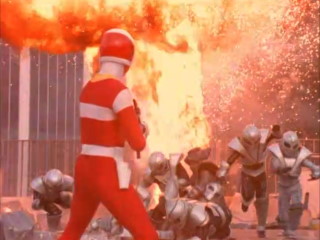
Since we were watching so many movies, herrDoktorat felt inclined to introduce me to his favourite Power Rangers series. I watched Mighty Morphin' as a young'un, and have rewatched the movie more times than I can count, but I never followed the series beyond that, so everything I know about the franchise is built off of ancient memories...!
Well, it's still Power Rangers, that can't be denied! Five teens with attitude battle monsters every week to protect the universe, sometimes with a kid-appropriate moral tacked onto the affairs. Don't be a snitch. Don't jack cars. Don't run off to avenge your long-lost sister without bringing your buddies along. That sort of thing.
But there's an ongoing plot, with story arcs, even! It's simple fare, but I think by having my expectations so low, to see the show tackle such simple feats like this genuinely impressed me. I expected episodic fluff and instead got ongoing plot threads, tying up loose ends from previous seasons, and totally unexpected stuff like an episode set in a wild west saloon doing all the old cowboy tropes... with ridiculous costumed baddies.
Astronema is easily the star. A total queen who steals the show, large and in charge and not afraid to throw down either. There's multiple twists wherein she bristles at the thought of Andros being her brother, before recovering her memories and joining the Rangers... before being brainwashed back into evil, where she then usurps multiple bigtime villains to become the true empress of evil. What a gal!
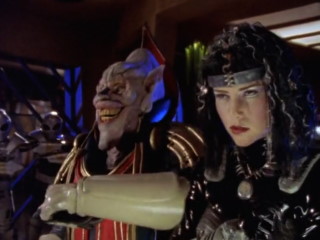
Seeing the show as an adult is interesting to see how much of it is new footage versus borrowed stuff from the Japanese show. All the giant robot stuff is recycled, but I'm surprised how much of it was original, some episodes almost entirely fresh material!
It's so interesting seeing story arcs built out of footage like this; some monsters seem like one-and-dones, but later reappear with a vengeance, carving a name for themselves once the western crew got to use the costumes themselves. Ecliptor begins a total jack-off villain who appears only as a glove when it's not recycled footage, but later becomes a breakout star of his own, whose undying loyalty to Astronema shines through no matter where her interests lie.
I wouldn't have watched the show without Dok, but I'm glad I did; to bounce discussions back and forth and hear his experience with the show was interesting. I'd been aware of the hardcore Power Rangers fandom, and I respected their interests, but didn't give it much thought. Yet the mix-up of cosmic and small-town shenanigans, the premise of these innocuous teenagers tasked with defending the universe against actual-ass evil... I can find myself pretty compelled by this. Now I'm upset there's no good story-driven Power Rangers game. What do we gotta do to sneak one past Saban?
Mega Man 9
PC (Steam)
May 23 ~ May 27
May 23 ~ May 27
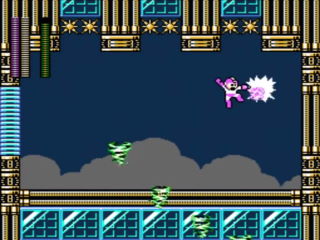
Mega Man returns and goes back to basics -- he's just not 8-bit, there's no charge shot, no slide, just the basic buster and maybe Rush Coil if you're lucky! The slide and charge were kind of easy to fall back on, rushing through stages and blasting through foes without much care, and while I wouldn't want it to be the new standard, I'd argue in this case ditching them does make the game feel that bit more unique.
Primarily because the master weapons are so good. This is why I like the game so much. Every weapon feels unique and has a distinct property to be utilised during stages. Splash Woman's trident, ordinarily a basic shot about as powerful as a charge shot, also has piercing properties that allow it to destroy blocks and kill foes behind shields. The concrete block is powerful and can freeze stuff, or even create temporary platforms against walls. Even Tornado man's weapon allows you to jump higher temporarily, something that can easily launch you into spikes if you're not aware, but becomes a handy tool once you know how to use it!
The stages have a terrific flow to them as well, usually boasting a stage-specific setpiece of some kind, be it against a mid-boss or a special challenge like Splash Woman's bubbles or the swinging platforms in Jewel Man's stage. Everything flows fast and smooth, granted you don't fall folly to not just the old staple of dastardly tricks, but new, nastier ones too.
That's ultimately the game's major flaw: it leans heavily into its "retro" difficulty, released in an age where "retro" often translated as "stupidly, unfairly difficult". It makes for a game that's probably refreshingly challenge for oldschool players, but inconceivably hard for newcomers. Resources are in short supply, and even grinding for bolts to afford things from the shop is tricky. most of what's on offer are one-time-use items...
... and the shop is entirely off-limits once you enter Wily's fortress, perhaps one of the most brutal end-games in a Mega Man, with difficult, belaboured boss fights... and no option to save partway through. The final area in particular is exhausting; after using all your weapons to defeat the boss rush, you then have to contend with a three-phase Wily fight, all of which can mess you up in record time. If you're going to use an e-Tank, you better be certain you'll make it through, otherwise that's one less resource for next time.
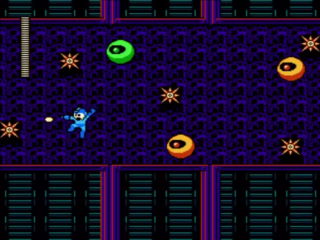
It's a game I wish I could happily turn off before playing the fortress, if it didn't keep introducing new unique challenges: platforms powered by the tornado weapon, a vertically-scrolling anti-gravity sequence where Mega Man's trajectory is dictated by his buster shots, and so on. The game continues to introduce new ideas to the end, even if they do get more and more devilish. I played this via Legacy Collection 2, which allows you to reload from checkpoints and retain your supplies, mercifully, but the inability to use the shop is maddening.
Mega Man 9 has got its foibles, from its brutal reliance on oldschool difficulty and perhaps leaning too heavily on its heritage: imagery and setpieces are lifted entirely from older games, including the bubble sequence in Wave Man's stage. Still, the game is extremely solid in my opinion; it shows that just by bringing out the best qualities in the tropes we've seen again and again - the same old weapons, the same old themes - it can still knock out a rock solid game from the old fundamentals. You don't have to completely shake up Mega Man to make it work, it just needs a bit of spit and polish... when we're talking 8-bit instalments, at least. I just said I wanted a little more from Mega Man 11, didn't I...?
Strikey Sisters
PC (Steam)
May 31 ~ Jun 05
May 31 ~ Jun 05

Figured I oughta check out the rest of DYA Games' output after Bot Vice. It's Breakout but with magical girls, sort of! Bounce a ball to break blocks while contending with enemies and hazards; once all the bricks are gone, enemies stop respawning and wiping them out will complete the stage.
Defeated enemies drop power-ups; some are buffs that change the ball or player's properties, while others are single-use abilities, launching projectiles or hazards that snare or destroy baddies and blocks. On top of all that, you can strike with your wand to attack nearby enemies or make the ball move faster, even charging it up to strike harder, thrusting the ball faster, and killing foes in one hit. You can even reflect enemy projectiles this way to deal big damage!
Although ostensibly a brick-breaker game, the constant flood of enemies make it very different from the norm. Juggling to keep your ball in play while also keeping track of enemies' unique patterns and player-focused attacks... you can't harm foes unless they're within melee range, and redirecting the ball towards them can be unreliable. At times it's better to just destroy them with power-ups, acquiring them from any bricks the ball breaks, arguably making the ball more of a formality than the real focus.
At least, you might think that way sometimes. It remains a ball-bouncing brick-breaker, and that's arguably where the game kind of fumbles. Since you play as a human figure instead of a paddle, it can be difficult to tell what's within bouncing range or not. The ball bounces slowly on its continued course if bounced off the player with no further action. If the wand is waved, it speeds up and bounces accordingly based on the position of the wand's arc, and goes chaotically fast when the melee strike is charged, allowing it to break blocks in a single hit.
But later in the game reflecting shots is a key element, and you'll want a shot charged to make use ofi t. This means you effectively sacrifice nuanced control of the ball just in preparation for an enemy shooting at you. And when you do need to direct the ball, your charged shot is bound to make it go out of control and into the gutter. One could argue it's a game of nuance, but also having a properly defined paddle would make such a difference.

It doesn't help that stages are built to make interesting set dressings more than they are practical challenges, and often blocks are buried deep in recesses that are hard to get the ball into, especially when directing the ball's bounce is incredibly tricky. The Dark Flames ability is essential for mowing down blocks en masse, or just sniping targets that are too much trouble to guide the ball towards.
The game is alternately zippy and bite-sized, yet drawn-out at times. All blocks require two strikes to destroy, making chipping away at hard-to-reach blocks all the more frustrating - it was fluke I got in there once, now I need to make the rebound! Some stages blaze by quickly thanks to fortuitous power-up drops, while others leave you at a stalemate between tricky architecture and obstructing enemies.
Beating a stage instantly returns you to the world map, where you can follow any number of paths in any order, so if one path is too tricky, you can clear off and try someplace else. The difficulty curve is hard to deduce when there's no punishment for retrying and retrying, but it's an appreciated gesture, and makes the game feel that more pick-up-and-play -- you don't feel compelled to play multiple levels in a row ala Wizorb. That and the locales tend to stand out, too. So many graphic assets...!
The presentation is boffo with lovely pixel art and bouncy, animated characters. All the enemies are recognisable and the music fits the mood pretty well. There's voice clips attached to special moves and even fully-voiced cutscenes before bosses, though like Bot Vice, the dialogue is rote and full of anime clichés, and even worse pop culture references. Throwing a Magic Bomb has the character declare "cool guys don't look at explosions", and it makes me groan every single time.
The story is at least more cutesy than Bot Vice, steeped in the parody fantasy anime style ala Dragon Half or Slayers, where the magical girls cause mischief in their quest to retrieve their pet. As a player it kind of stinks being roped into an arbitrary boss fight against monsters who seem otherwise amicable, but it fits the bill for the kind of weekly plot-moving shenanigans in Slayers.

Strikey Sisters has a far more arcadey vibe than the likes of Wizorb, but it's very much a beast of its own making. Managing enemies is as key as breaking blocks, and it makes for a very different game flow than the typical entries in the genre. Whether it makes an impression is a total crapshoot, there's no easy points of comparison.
It's interesting, but perhaps a bit too chaotic and unfocused for its own good. there's a lot of content, with a decently-sized story mode and fifty-something bonus stages after you've beaten the game, but the difficulty curve is wishy-washy and even 'mastering' the game feels uneven, making good progress hinges mostly on good power-up drops and learning the strange idiosyncrasies of melee-angles.
Sum-up? it's fine, but it's just a bit mushy for my liking. some good factors like the presentation and pick-up-and-play arcadey factors, but the game design has so much going on it's a bit hard to keep track at times.
Super Star Path
PC (Steam)
Jun 6
Jun 6
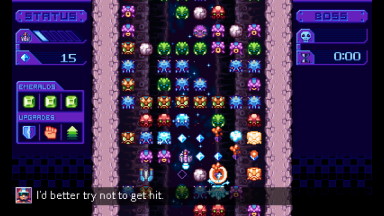
I forgot I had this in my Steam inventory and figured I'd give it a spin, having played DYA Games' other titles. Billed as a fusion of a space shooter and a colour-matching puzzle game, but arguably more of a maze game...? Shoot aliens of the same colour to destroy the chain, but any monsters at the end of the 'chain' will be crystalised and rendered indestructible.
The incentive is to destroy big chains to get lots of loot, but the real focus is simply to make it through to the other side; it can be very easy to trap yourself by crystalising essential aliens, or simply going down a path that has no path you can blast through.
As such, any hope of this being a score-based puzzler feels like an afterthought, when simply navigating through the web of monsters and hazards is the real challenge. Stages introduce particularly nefarious traps like detonating mines and flamethrowers that will destroy alien chains, and cannons that fire to your current position. Given the game's very nature of navigating cramped spaces, the projectiles are particularly treacherous, and identifying hazards amidst the web of coloured aliens can be tricky, especially when a spike hazard might look like an innocuous purple sphere at first.
At the end of each stage is a relatively standard shoot-em-up boss, with bullet hell patterns and the like. It's about what you'd expect! The game has no mid-stage power-ups or any other shmup conventions, so you just have to dodge the shots and fire your own when you have the chance. It's expected of the genre, but arguably not a great fusion of the two gameplay styles, switching from tactile and methodical navigation to just bullet frenzy. Neat that it's there, but...!
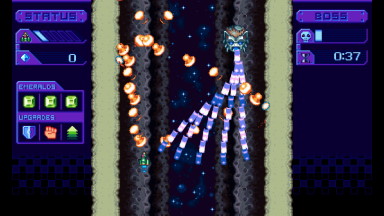
A bit like Super Puzzle Platformer, it has a pretty harsh approach to failure; the level patterns are randomly generated, and at times it feels like complete luck of the draw if you can get through it at times. There's no checkpoints, so dying at any point -- even against the boss! -- puts you back at the start.
It's hard to feel like you're even learning the game's mechanics so much as re-rolling for a more forgiving layout. Some runs were relatively painless, while others had me flying through gauntlets of lasers and enemies with no breathing room, or getting walled off with crystalised enemies because a laser had detonated them with no chance to interfere.
You can buy new ships that boast unique traits, and upgrade their strength, defence or mobility with the appropriate tokens. Most of the ships merely boast resistance to certain attacks; the only notable one is the diagonal shots, which effectively deal double damage against bosses if you rebound your shots off the walls at close-range.
Money is earned from chains, but tokens and emeralds are only found by killing rarely-seen aliens shaped like samurai helmets. Emeralds seem to be a recurring collectible in DYA Games' stuff, but this is the first where they're essential -- if you defeat the final boss without having collected them all, it'll just kill you anyway. Go back and get them all, shithead! Not that the plot or ending is worth the hassle, but still, way to rain on my parade.
Presentation is to the usual DYA standard -- great animated pixel art, fitting music, and somewhat incessant voice acting. You can at least turn off the voiced radio messages, which serve only as idiotic tutorials and fluff filler.
Beating the game unlocks a boss rush, which I beat in 18 seconds using the diagonal shot trick. There's no extra content besides the difficulty settings. It's the cheapest game in DYA's library, and it kind of shows. It's an interesting idea taken in a direction I'm not particularly enamoured with; shmup fans and puzzle heads alike might not be particularly sated by its gameplay, though I'm sure there's someone out there who appreciates it.
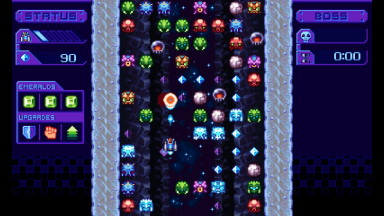
I confess I was hoping for something that was more puzzle and score-orientated; or heck, if the game had a slower, more methodical pace, navigating and backtracking through the web of aliens could be a compelling puzzler. Having several turns to perform actions before the wave advances, a bit like a Mystery Dungeon game maybe. As is, it's more of a shmup cum maze game, a quirky curiosity, but one that kind of clashed with my wants.
It's one of those games that really shows how paying for something encourages you to make the most of your money; if it were a free release on The Daily Click or made in Flash, it would draw people's eye for its lavish presentation and unique concept. As a £5 Steam game it's a perfectly adequate price, but you feel like it deserves a bit more oomph. I don't know. An interesting experience, but I've zero incentive to revisit it.
Dragon Bros.
PC (Steam)
Jun
Jun
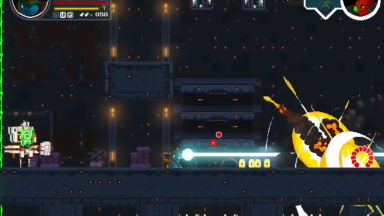
A game I'd had on my wishlist forever based purely on its appealing Steam Greenlight page, but I don't think it had ever gone on discount. In theory it should be right up my alley? It's a 2D run and gun shooter, a mixture of Metal Slug and Contra! And it's got dragons!
Playing the game shows even more to be enamoured with, as there's a mixture of gunplay and basic melee moves, including a downward slam that's limited in use but rewarding to pull off. The map is split between large levels that count towards progress, and smaller one-off challenges typically built around a central gimmick, be it a specific weapon, using the roll command, or even a straight-up Space Invaders homage. The concept of mixing longform and shortform challenges is something I crave and exactly what I want more of! Heck, the game even brings up the difficulty select before each stage, allowing you to finetune the challenge without backing out through menus. What a treat!
... sadly, the game itself just leaves a lot to be desired. For all its running and gunning, the game somehow feels very tepid? Your movement is limited, with a tiny jump that has difficulty even reaching low ledges, and a roll command that's almost too good, flinging you further than you'd expect. Not that the game dabbles in much platforming; levels are stop-and-go affairs wherein you're forced to weed out slowly-incoming waves of enemies.
Gunplay just feels limp. The viewing space on screen is massive and your default shot fizzles out halfway across, I assume an effort to stop you from sniping everywhere. The default gun is weak and piddly and has a sluggish auto-fire; you're forced to spam the button to get a good rate of fire going. Melee is inefficient thanks to its crummy range and the fact you take collision damage, and the slam attack is good only from high elevations; your jump isn't even good enough to jump over enemies with ease.
Only in designated areas do you pick up new weaponry, and they feel designed to be as inefficient for the current area as possible...? The shotgun has absurdly short range, other projectiles move incredibly slowly, and you never seem to have much ammunition. The weapons are collected from bubble icons, which in no way suggested "new gun" to me, so by the time I realised they replaced my peashooter I'd already have burned through most of the ammo.
Defeating enemies drops pellets that fill up your Ultra metre: activating it will temporarily increase your damage output and range... when I say temporarily, I mean temporarily. It lasts barely five seconds! It does fill up quickly enough, but it means collecting more pellets is a waste; the gauge can't be refilled until it's emptied. Since you're stuck with the pea shooter most of the time, you're forever burning through Ultra just to make a dent in the crowds. Killing dudes to recharge energy required to kill more dudes is a mechanic that could be interesting if applied correctly, but it just came across like they forgot to balance the weapons correctly.
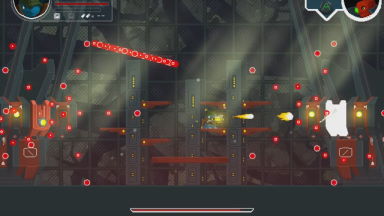
Checkpoints are semi-frequent and refill your health, meaning each chunk of a stage plays like a dedicated challenge; there's no lives, so you never have to worry about redoing the entire stage unless you quit manually. Levels tend to go on a little too long for my liking, and by the second world had already gotten tiresome.
The first boss was also extremely lousy, pitting you between two orb-firing cannons and giving you a laser with barely two seconds of fire in it. The challenge was negligible, it was just maintaining the patience to last it out and not throw yourself into incoming fire.
I simply wasn't having fun with the game. It boasted so many design elements I wanted to love, but the execution felt so, so tepid. For its hard rock soundtrack, the action never feel intense or fast-paced, and a myriad of factors -- the lack of weapons, the collision damage, the weak shots -- meant there was no incentive to do anything but camp and wait for enemies to come to me. The game slowly introduced new threats and enemies, but the only notable ones were traps that move to the beat of the music, and robots that were only vulnerable in their teeny tiny heads. I figured if this is the only meaningful thing it's introduced, then I've no hope for the rest of the game.
It pained me to ask for a refund, as it's a game I long wanted to try and enjoy, and if nothing else I want to support indie devs... but I was getting zilch out of it. I could've made an indepth review picking it apart, highlighting what it did right and what it did wrong, but I've enough needless projects as it is. I bought this game for something to enjoy, not give myself more work!
Handsome Mr. Frog
PC (Steam)
Jun 19
Jun 19
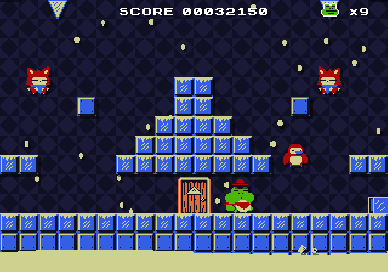
I don't exactly go scrounging for them, but I'm always intrigued when a new single-screen arcade game comes along, so I was overdue to give this a spin. Enemies fall on screen from the top corners, and it's your job to dispose of them by licking them up and spitting them out again into each other. Failing that, just bash them for a box for less points.
Enemies bounce off-screen when they're clobbered, and you get multipliers if more enemies are hit in a chain reaction. After four waves you move on to a new area, progressing through four themed levels before it begins recycling layouts but with a grab-bag of random enemies.
Its physics are very heavy and weighty, making it stand out from classic clear-the-enemies arcade games like Bubble Bobble or the like. The fact it's so immediate is perhaps kind of jarring -- Super Mario Bros. 2 would have you jump on an enemy first before picking them up, or Mario Bros. knock them from beneath to stun them. Bubble Bobble and Snow Bros limit how you can 'manoeuvre' a captured enemy... but in this game you just lick 'em up and spit 'em out. It's simple, but almost jarringly simple. Where's the complexity?!
That comes largely in monitoring enemy behaviour. They all have basic patterns; birds will chase after you and jump if they have to, while crocodiles just walk straight forward. penguins can build up crazy speed by sliding, while ghosts can phase through walls, and so on. Unlike other arcade games where enemies turn around on contact or simply phase through each other, Handsome Mr. Frog's foes bounce off each other like walking bouncy castles, hurling them across the map at unpredictable velocities. It's not enough to know the patterns, it's steering clear of an unexpected cannonball!
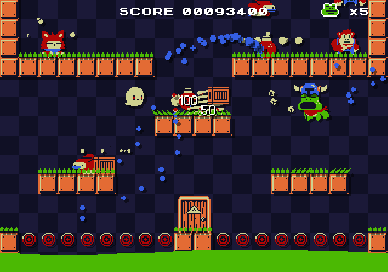
It's only after the four themes are completed that the game truly opens up, with a seeming random selection of enemies now in old stages. The first loop only uses two enemy types per stage, intentionally designed to contrast a simple pattern with a more complex, adversarial behaviour. The new levels ditch that and throw everyone into the same pot, presenting something a trifle chaotic and overwhelming, forcing you to make use of the wrapping screen to duke them, avoiding projectiles and the like.
The game can feel a little cramped and perfunctory at times, though; the graphics are big and boast some fun cartoon detail in their limited palette, but it means there's far less screen real estate than even the likes of Donkey Kong Jr.
Enemies can creep up on you real fast, at times too fast to process what just killed me! Collision detection's perhaps a bit fiddly, with Frog bigger than you'd think and his projectiles smaller than you'd hope. All that, and it's still very much an arcade game -- you still have to play from the very start every time. If you want to practise on the second wave, you just gotta get good and hold onto your stock of lives.
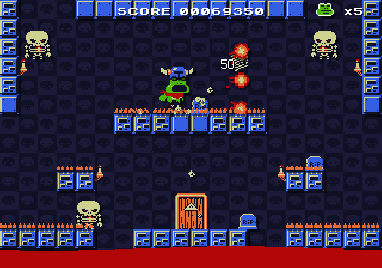
Still, the game's simple and pleasant enough. The retro aesthetic is charming, with little flourishes like rotating sprites and sweeping grass to give it some spice. There's no music of any kind, the soundscape is little more than spartan bleeps and blorps, with heavy 'thunks' for enemy collision, sounding like the physical sounds for the arcade Donkey Kong.
It's distinct, but also means the game kind of lacks a hook until the gameplay wins you over; there's no bouncy themes to sweep you along for the ride, it hinges entirely on the game itself clicking with you. Which is fair, to be honest. It's a strange thing to compliment, but there's some games I wish would let the game speak for itself without flourishes. Do I really like this, or am I just enamoured with the window dressing...?
The arcade presentation does mean I'm rarely in the mood to play it; being able to skip to when things spice up would be nice, or even the option to randomise the themes and enemies, but it's a very lo-fi game on all fronts. It's cheap as chips so it's hardly going to induce buyer's remorse (lookin' at you Dragon Bros!!!), but it's very old-school in its design.
Banjo-Pilot
Game Boy Advance
Jun 21 ~ Jun 23
Jun 21 ~ Jun 23
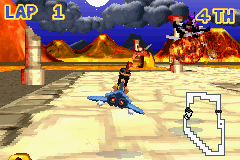
Found myself with an inexplicable hyperfixation over this game! It's pretty much exactly what you'd expect from a GBA kart racer... only now there's a Y-axis as well! It's somewhat negligible, as there's no elevations to contend with outside of the occasional road hazard, yet you feel like it adds something to the game; orientating yourself to hit boosts and grab items, determining where exactly's the best place to lay an ice trap for enemies to crash into, that kind of thing. You still slow down if you fly off the 'track', an inexplicable notion that's just an unfortunate concession for not having 3D-rendered walls to crash into.
The game doesn't have quite the finesse as Diddy Kong Racing, sadly, but it's got its own fun meta. The ice cubes aren't just for laying traps, but also for destroying incoming projectiles; failing that, you can flip and somersault with the L Button, which evades such hazards and even nets you a boost if timed correctly. Of course, if there's two projectiles on your tail at once then you'll crash and burn no matter what, but it's satisfying to pull off and can potentially turn the tide if you're stuck in a crowd.
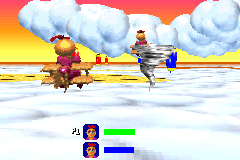
After the grand prix's four races you face a final challenge before the trophy is yours: a 1-on-1 dogfight! You take turns playing offense or defence, either shooting at your weaving foe from behind, or avoiding incoming fire and grabbing items to ward them off. It's just more Mode7 but it's a great showcase of the GBA's effects to sell the vibe of flying high above the land.
I'd argue it's a pity more grand prix modes don't mix things up like this; why should Mario Kart settle for four races when they could throw in a battle arena as well? Put all your skills to the test, not just racing! It's a cute way of capping off the grand prix, although admittedly a trifle pointless; you can retry the dogfight as many times as as it takes, and the ultimate tactic to evade enemy shots is simple to fly counter-clockwise around the edges of the screen. It's a fun change of pace up until you learn how to break it...!
Another fun addition that harkens to Banjo's crap-collecting mentality is Cheato. Winning any challenge earns you pages, a currency that buys you new characters, new multiplayer tracks, new cups, or even Glowbos; these fuzzy critters show up on tracks once unlocked, and activate limited-time boost pads when shot. The wares are only updated sparingly as you make progress, but it's a neat extra and also a nice incentive to replay stages if you have to; collecting Notes in the GP will multiply your reward of pages, so you can knock out a couple hundred for every four races you do. The Glowbos aren't necessary, but they come in handy especially in the Jiggy Challenges.
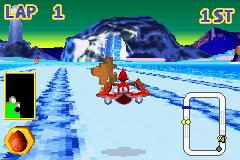
The Jiggy Challenges are this game's equivalent of the Silver Coin Challenges from Diddy Kong Racing; you have to collect the six Jiggies throughout the course and also beat Bottles to the finish line. It's right up my alley, though not quite as intense as DKR; racing against only one opponent is a bummer, although Bottles is faster than any other character in the game. The lack of 3D spaces to explore for Jiggies is disappointing but understandable; they can still be difficult to see due to the draw distance, though they're also marked on your mini-map for convenience. A fun challenge and a neat way of maintaining the collect-a-thon theme.
Ultimately, the game's difficulty is kind of hit-or-miss. The AI racers all tend to drive in a line until they start attacking each other, and how capable they are of catching up is pretty variable; even if an opponent is a thorn in your side during one race, they're lucky to hold a consistent enough score to challenge your position in the rankings. The entire time trial mode is a bit of a waste, too, as without the hurdle of 3D environments and the finesse of DKR's boost mechanics, it takes no effort to beat the records besides knowing where the boost pads are.
Once you clear the Jiggy Challenge, you unlock Bottles as a playable character... and by that point, the game might as well be over. Bottles is the best character in the game, quite simply. He's faster than everyone else by an outrageous margin, with killer acceleration and handling to boot. Unlocking him for play also adds him to the roster of CPU opponents across all modes, so now you are forever doomed to 2nd place in every race; you can expect him to be halfway around the track by the time you reach the 3rd lap, with no hope on earth of catching up.
On that note, beating all the time trials (which I didn't bother) unlocks the Rare staff's times, which are finally somewhat challenging... and made exclusively for Bottles. No one else has any hope of breaking the records. The lap times are pretty tight, but the course records don't require more advanced tactics than the old ones, outside of getting used to the mole's squirrely handling.
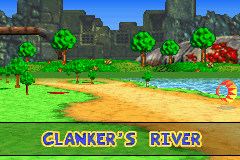
Clearing the game also unlocks the Jinjo GP, effectively the game's hard mode, queuing up six random courses and pitting you against extremely fast Jinjos who give the regular cast a run for their money... but Bottles can outpace them with no effort involved. Characters like Humba Wumba are just too slow to keep up without fortuitous item usage, so the mode effectively turns into a question of "what's feasible?" Bottles is too fast, but Humba and Jinjo are too slow. Does that leave Grunty, Banjo and Klungo as the only feasible options...? And thus the game falls into the interminable well of dodgy balance, where the devs throw up their hands and leave it to the player to sort out this mess.
Perhaps the biggest takeaway from Banjo-Pilot is the game's set dressing. By reusing the same basic tilesets (grass, beach, desert, ice, lava) but applying a different backdrop, it kind of sells the idea that these are varied locations. Treasure Trove Cove really looks the biz just by pasting the familiar arch-shaped island into the background.
Clanker's River looks identical to Spiral Mountain, save for the big mechanical whale parked in the distance; it's cheap, but it gets the imagination whirring. What would the big lug be like if he got out of that dingy cavern? The Grunty GP even recolours all of the levels to some degree to at least give you something new to look at, which is appreciated. It almost makes me wish more 3D collect-a-thons reused assets in such a way, and not just Super Mario Galaxy's remix stars.
Banjo-Pilot is fun while it lasts, though the more you play the more cracks in its design begin to show. The vertical movement is only there to facilitate hitting collectibles and boosts, and rewarding good placement of traps. The item roster is simple and lacks the risk/reward factor of Diddy Kong Racing, where stocking up on boosts or missiles could really pay off. Until Bottles tears the difficulty a new one, it's a breezy enough game that's well suited to quick pick-up-and-play sessions, especially with the ability to save your progress in the middle of a grand prix. You don't need to marathon 4 races in one sitting! Mario Kart still doesn't do that!
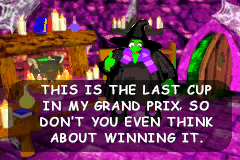
A big dumb tirade about characters or something, I don't know:
I'd argue it's a bummer that the game was released as Banjo Pilot. The 2003 prototype of Diddy Kong Pilot has heaps more visual flair, really corny voice acting from characters we rarely hear form full phrases, and the cast of Donkey Kong Country just feel more... appropriate for this kind of thing? Like, all the major characters are movers and shakers in some form, and could feasibly hop into the ring if given the chance; ever since Mario Kart Wii Funky's shown he's more than just a travel agent. When's Candy Kong gonna prove herself? Or get a character design that isn't terrible?
Acknowledging that made me realise that Banjo's kind of a weird franchise by comparison. So many video game series have casts with impetus, with purpose, who go out and do things. Banjo only barely fits those qualities. Heck, Banjo himself is barely a protagonist, but he'll do in a pinch. He's the hero because he's the only one in Spiral Mountain with actual legs, probably. Each game in the series comes with a cast of dozens, but never people with ambitions -- just folks desperately in need of a sucker to do their dirty work. You enjoy the cutesy-snarky aesthetic, but you're rarely itching for a chance to engage more with the world, y'know? They're all dickheads!
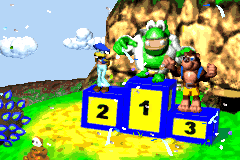
I guess something about Donkey Kong Country lent itself more to projecting feelings onto. Its dialogue (courtesy of Cranky) is in a similar vein of British irreverence, yet it feels like it has a more earthy and dramatic tone to it at times. Probably thanks to its beautiful pre-rendered backdrops and atmospheric soundscape it used in its SNES trilogy, but also for the implied lineage of the Kongs, connecting DKC to the arcade games, Diddy Kong Racing to Rare's other spinoffs, and to the greater Mario universe in general. Even when it's dumb as heck, you know it's part of something larger; when K.Rool's up to no good, you can assume Wario or Bowser are out there in the world also being assholes.
I think what put me onto Banjo and this bizarre tirade was exploring fangames for my YouTube channel. I've been on a weird fangame kick all year -- not just recording them, but spitballing ideas if I were to ever bother farting around with Clickteam Fusion for more than just silly animations. My particular ax to grind is seeing underrepresented characters... get represented!
You'd be shocked how few Mario fangames give Peach a shot in the spotlight. I don't care if it's no different than the dime-a-dozen clones out in the wild, to make a fangame starring Rouge the Bat or Paper Mario's Vivian or even freakin' Groose, I dunno, would automatically give it a leg up on the competition. The official games certainly aren't gonna cover that base! It's free real estate!
Yet as much love as people have for the extended cast of Donkey Kong Country, it's rare to see that love extended to Banjo's rogue's gallery. They're cute and amusing, but never worthy of getting invested in. Nobody's thinking "Mumbo Jumbo absolutely deserves his own game". Son of a bitch barely even deserved to be playable in Banjo-Tooie, honestly.
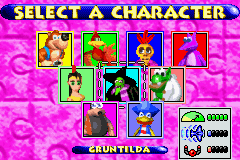
This is a long, roundabout way of saying that Banjo Pilot has a weird roster. How do you make an exciting lineup when the cast are all idle homebodies? It's cute to see the Jinjos join in, and getting to take control of Grunty and Klungo in some fashion is a novelty. But... Jolly Roger? Not even Captain Blubber? He's the one character who canonically drives!
He's a main character and all, but I don't think anyone was hankering to play as Bottles, who's essentially the fursona of your boring neighbour. Kazooie aside, absolutely none of these characters go looking for trouble or adventure, and to get them into vehicles could only have happened with prodding and negging. Please write in to tell me if my interpretations are out of line, though.
The GBA and DS are littered in bizarre licensed racing games, from Shrek to Antz to Digimon to goodness knows what else, all seemingly baffling choices to everyone except the superfans of those specific franchises. And as much of a following BK has in some circles, even I struggle to think, yeah, of course I want to play as Kazooie in a plane-based racing game.
I mean, to be fair, it was the best kid-friendly series Rare had after the buyout that could almost be considered recognisable. What's the alternative? Killer Instinct Kart? Grabbed By The Ghoulies Grand Prix? Battletoads Bikes could've been a contender, though. Rare's got franchises, but who wants 'em...?
The Simpsons: Bart vs. the Juggernauts
Game Boy
Jun 29
Jun 29
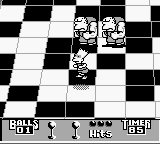
A game I first discovered through dodgy old Spanish multi-carts, and next to Road Rage is perhaps the Simpsons game I've put the most time into... even though I never got past the second set of challenges. Time to put an end to that!
Yet another bloody Imagineering game, responsible for Bart vs. the Space Mutants and all the other dodgy NES and Game Boy entries. This one stands out by being a glorified mini-game collection, pitting you against an increasing number of challenges each 'week' as you try to earn enough points to pass the score threshold.
The games range from glorified circus attractions, a grid-based capture the flag run, and various iterations of one-on-one combat. It's all loosely inspired by American Gladiators, with silly sports-like premises, lots of bodily collisions, and the occasional deadly trap thrown in for good measure.
You're given three attempts at each game, and there's just enough strategy that working out how to get the highest score is fun to figure out. Is it worth risking the lives bonus just to save time and score more balls in the tile game? The nuclear power plant arena has some trickery where you can deal double damage by hitting where the opponent is exposed, or whacking radioactive ooze at them... but it's also just as effective to jab endlessly.
The mini-games are relatively self-explanatory, barring a retry or two... except for the wrestling game. The goal is simply to shove the opponent out of the ring, yet all of Bart's moves are nigh useless. The seemingly worthless jump button is instead where all the best moves are hidden; holding up and double-tapping performs a mean dropkick, while holding down and double-tapping causes Bart to bull-rush forward.
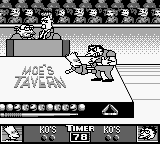
Trying to play normally is an exercise in frustration, trying to figure out what you can and can't do, when and why the opponent just bounces you across the ring for no reason... but if you use turbo and hold down you'll just bull-rush them out of the ring in seconds flat.
Admittedly playing for score is more important than a quick finish, and sometimes that requires drawing it out as long as you can. Earning and wasting extra chances in the skateboard mini-game are what nets the highest reward, as well as last-second finishes in the wrestling ring. So long as you beat all the games you're usually good, though it can still be a bit of a crapshoot; I failed the final week's threshold by 2000 points, and then beat it by twice that on my next attempt, despite no changes in tactic.
The game is pleasantly spared from Imagineering's dodgy platforming... right up until the final week. It's the one event that's not timed, meaning nothing's stopping the devs from building the tallest, most obnoxious level they can imagine. Visibility is lousy with key jumps indicated only by a tiny dangling rope at the top corner of the screen, and it's very easy to lose stacks of progress not even with a whiffed jump, but just Bart's slippery controls. It's not great, and a hell of a crummy way to end the game. Heck, I'd argue all the games introduced past the first week don't hold a candle in comparison, but it's the novelty of seeing something new, innit.
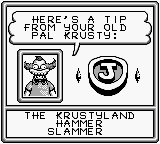
I always find a certain charm to seeing the Simpsons characters rendered in monochrome pixels, including bit-players like Marvin Monroe or Lance Murdock. Things are relatively on-model given the limitations, which makes it all the more special when Bart undergoes some ghoulish wild-takes, a very misshapen Barney appears in the wrestling ring, and Krusty... is perhaps the most frightening he's ever looked. They're few and far between, but they made my day.
It's neat to see the game to the end; it arguably wasn't worth it, but I can't get too salty over spending an hour or two on it. It's a pity this was Imagineering's one attempt at a non-platformer (or at least, didn't mutate into one after the first level ala Bart vs. The Space Mutants), as it's arguably a more compelling format if just for the variety. Not that it's actually, like, good or anything. Once again I find myself making concessions for absolute stinkers...!
Banjo-Kazooie: Grunty's Revenge
Game Boy Advance
Jul 04 ~ Jul 16
Jul 04 ~ Jul 16
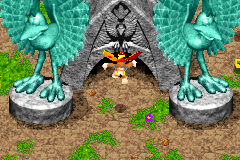
After Banjo-Pilot this is the last Banjo game I've yet to finish, though not for lack of trying -- this was my third stab at it, but on all prior attempts I just bounced off it completely. I would slog through the boring first world, maybe reach the beach, before ultimately dropping it. Does it pick up after that...?
Banjo's converted to a 2D approximation of 3D pretty well on GBA, at least from a visual perspective. Many of the same assets and animations from the N64 games are converted into pre-rendered graphics, so everything looks as you remember them. Familiar characters use the exact same animations as before, and although the locations are new, they tend to evoke iconic locales like Treasure Trove Cove or Bubblegoop Swamp.
Whether you can tolerate playing from the top-down perspective is another matter, though. Losing the analogue movement takes some getting used to, though the controls are adequate, if a bit fiddly to keep track of all the commands. Depth perception becomes very tricky without a true sense of perspective; where is this platform in 3D space? Is this platform in front of me or high above me? The first two stages are very light on platforming, using hills and walls only as a means of segmenting different areas of the map, with proper jumping skills only required for hidden goodies like empty honeycombs.
Admittedly the game has a very sluggish start. The first world has extremely little to offer beyond learning the bare basics, and the beach is an iffy hodge-podge of duff mini-games and undersea navigation. Once you get Kazooie things start to liven up, not just by adding more traversal options, but also by having the familiar back-and-forth banter between her and the characters you meet. Banjo's cute, but he lacks moxie, y'know?
Later stages place a lot more emphasis on platforming, and it's a source of unwanted difficulty. Bad Magic Bayou's upper half is built on slanting slopes and verticality that's very hard to perceive, with key progress behind near-blind jumps. It makes one take for granted how compact the first two worlds are; later worlds and especially the hub are almost needlessly sprawling. If the graphics weren't so big it might not be so bad, but you've so little visibility...!
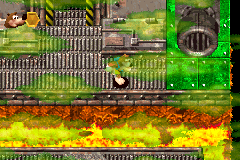
Navigation isn't too tricky, but the lack of visibility makes it an endeavour; it's not like the 3D games where you could stop and adjust the camera to observe your surroundings, or even enter first-person to scout out a path. Grunty's Revenge gives you no option but to simply wander, so you better get acquainted with what few landmarks there are!
Maps are usually segmented into at least three 'screens', so there's that, though at times the linking point is less than clear; it took an hour of wandering Spiller's Harbour before I even realised there was a third screen, its entrance marked only by an insignificant change in the floor tiles.
The game has only five worlds, and it makes for a somewhat sharp difficulty curve. Cliff Farm is a pushover, Breegull Beach is when things get a little more interesting... and then everything afterward just throws you in the deep end. Bad Magic Bayou, Spiller's Harbour and Freezing Furnace are all bordered by hazardous water, Bayou and Furnace almost exclusively on narrow platforms suspended above the stuff.
The Bayou is a little more courteous about it, but the other two go absolutely ham on their population of tough, tenacious enemies who are hard to shake off! Matters aren't helped when some enemies can only be killed by a specific attack; unsheathing Kazooie into egg-firing mode takes so long you're bound to take damage if you aren't quick about it.
It doesn't help that it loves ramping up the enemies' durability too. There's multiple recolours of Gruntling and Whiplash that take multiple attacks to defeat, and can even knock off 2 to 3 hitpoints in one go! The game has infinite lives and respawns you at your last entry point, so it's never truly progress-stopping... but it is a bit obnoxious.
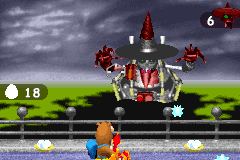
A collect-a-thon always brushes against the ceiling of variety and feasibility, and the formula of Grunty's Revenge becomes obvious pretty quickly. There's always Jinjos to find, at least two mini-games and one set of arbitrary collectible before you get a Jiggy, at least one usage of a transformation, plus a boss fight. I'm sure you can break down the N64 games in the same way as well, but without the whimsy of three-dimensional worlds to explore, there's a lot less distractions to gussy it up.
The game ends up feeling a tad cheap in its latter half... not just because of difficulty balance, or the somewhat under-utilised final upgrades, but also in production value? Some of Freezing Furnace's design decisions feel a bit egregious, even if I'd be hard-pressed to pin down why. Oddly convoluted navigation, even more worthless gubbins to track down, and an igloo that just plops you into another mini-game rehash instead of a new area. After the appearance by a young Captain Blubber, it seems a perfect spot for Boggy to show up -- and indeed, he's got sprites buried in the ROM, totally unused. It just seemed a tad out of place even before I knew that, I don't know.
Bosses are rarely the highlight of these games, so it should be no surprise they're all a bit crap. Grunty and Klungo are the only two bosses in the game, fought multiple times, and they both amount to watching them run through their patterns and waiting for their shields to disappear.
They're easily exploitable, and the first Grunty fight even has a safe spot where she can't hit you with her stomp attack. The most interesting of them plays out like a shooting gallery where you must avoid Grunty's projectiles while aiming for her weak spots; I wouldn't declare it good, but the variety is appreciated.
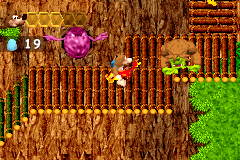
You only need 50 Jiggies (out of 60?) to access the final battle, and it's a bit shit: it's just a rematch with Grunty, Klungo, then Grunty again, all using patterns we've seen already with only minor additions. It also busts out the ol' quiz game schtick again, though the breadth of questions leaves something to be desired, and sometimes it just chucks you a mini-game to finish.
This isn't just a bore (it's made us play all the mini-games twice already!), the ice-fishing mini-game is particularly nasty as you run the risk of losing health if you pick up a crab... and there's very little clue what you're picking up. You might have all your health intact after round one with Grunty, and then be on door's death again because of a mini-game!
On top of that bullshit, the very final phase involves Grunty splitting into three ghosts and you have to hit the right one, otherwise you take damage. I only ever reached this phase with low health, enough to kill me for a wrong guess. Maybe it is instant death? It's a bit of a shit surprise, I tell you what. You're meant to hit the fastest one, by the way.
Oh, and if you die at any point during this four-phase battle, you're kicked back to Spiral Mountain and have to do it all over again, including the timed event just to open the boss door. It's not a difficult fight, just marred by multiple unexpected crapshoots.
The game is cute, and I'm a sucker for any opportunity to horse around in the Banjo world; seeing new characters, the amusing dialogue, the few times it actually addresses the time travel plot in a meaningful fashion. But I'm hard-pressed to say any of this is must-play material. So much of Banjo's appeal was in its rich 3D worlds, and to flatten them down like this takes away a lot of the charm. Would even hand-drawn sprites have made a difference...? It just feels like a bit of a hollow experience. What am I really getting out of a portable Banjo?
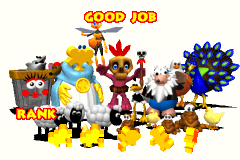
The final time on my completed file was just shy of 3 hours, though I'm pretty sure it was at least 4; I don't know if deaths and retries are counted as part of the final time. Kudos for not wasting my time, I guess! 50 Jiggies is a digestible amount, though the final challenge was absolutely not worth sticking around for... and now I'm wondering what was worth sticking around for. Ooer.
I've heard rumblings of the game's troubled development, so I can understand the game leaving something to be desired; to try something so out-there when Rare's foundations were shaking must've been an endeavour. Learning the game began development on Game Boy Color as a 2D platformer had me pining for that instead, though.
It was neat of them to try, but honestly, it's the one Banjo game I'd dare say you could safely ignore. It's a novelty seeing the bear and bird come to handheld, but it's hardly innovating through limitations the way Super Mario Land did.
Sonic R
SEGA Saturn / PC
July 11 (SEGA Saturn)
November 24 (Improvement Mod)
July 11 (SEGA Saturn)
November 24 (Improvement Mod)
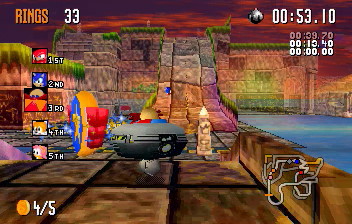
When I played this in 2016, my preferred method of play was to try and complete a stage 100% in one run -- that is, collect all five Sonic tokens, get the Chaos Emeralds, take first place, and beat the rival in a single go, no picking up the pieces later. This year I made a point of recording a playthrough in that vein as Robotnik, one of the slowest characters!
I love Sonic R.
No, it's not a good racing game.
Its character roster is wildly unbalanced in speed and skills. Its courses, colourful and vibrant as they are, can be hard to follow at times and invariably have a route that's guaranteed better than the rest. And did I mention there's only five courses? What a swiz!
This is where I remind everyone of my undue love for Diddy Kong Racing and its Silver Coin Challenges, and how the oft-reviled trinket-hunting mode, an obnoxious roadblock for most folks, just scratches my itch for multi-tasking. It's not enough to win, you gotta run these other errands in the middle of a race and then win!
And personally, that's where Sonic R excels. Playing it as a straightforward racer does not do it any favours, and once you know the optimum routes -- even as slowpokes like Egg Robo, even on Hard difficulty -- is usually enough to outdo everyone. But when you start treating the game like a competitive collect-a-thon, where you have to factor in all the items you need, the rings required to unlock gates, while still keeping on top of your opponents... that's when it really gets intense.
I've long wanted to write a big gushing love letter to the game, because it's such a distinctly original take on not just racing games, but a mascot making the leap to 3D for the first time (ignoring Sonic Jam; you can't convince me Sonic 3D is a 3D platformer, sorry). Ill-received as it may be, it's such a bizarre little labour of love, and one I can't help but adore. The write-up's still on the cards, I want to do it sometime, but I want to do it justice. Until then, the video commentary will do as a teaser!
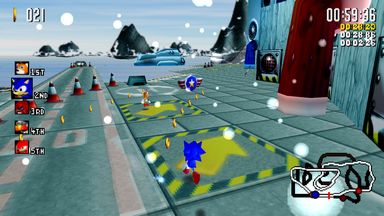
Sonic R Improvement Mod: Hey, the Sonic Hacking Contest had something right up my alley! This mod patches the .EXE itself to hard-code speed and control adjustments for all the characters, as well as making the hitboxes for items larger and easier to collect. As far as quality of life fixes go, it sounds minor, but it makes a big difference! The amount of runs that've gotten botched because I missed a Chaos Emerald by mere inches...!
The Mod Launcher also adds a bunch of optional additions, mostly various toggles for AI opponents, including tougher bosses, dynamic difficulty, and always using the hardest foes, rather than segregating the opponent lineup between classic and metal characters.
This turns the opponents into proper challenges, particularly the rival races -- where formerly the Egg Robo would be lapped by the end of Regal Ruin, he was right on my ass the whole trial, which is a turn-up for the books. The metal foes are already tough, but I had some serious trouble taking 1st place against Metal Knuckles and Egg Robo...
... which is unfortunate, as if you want your Chaos Emeralds to be added to your total, you need 1st place. You can't unlock Radiant Emerald unless you get them all! That's a new addition that kind of oversells the course in my opinion, but it's an appreciated gesture to add some measure of difficulty to the game, so you don't just finish it all in a half hour.
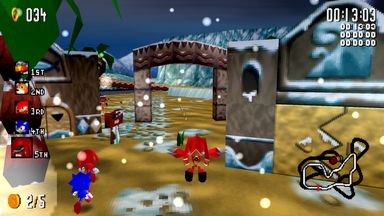
My petty quibble is that this serious spike in difficulty means my preferred method of play, getting all collectibles in one run, is more than a little infeasible. I can just about get all the Sonic Tokens and take first, but to get the Chaos Emeralds as well is enough to make me lose my lead.
Again, all the difficulty options can be toggled on or off in the launcher, so I could just fiddle with things until I find a happy medium. It just burns my britches to see the game get so close to an earnest balance, and then I have to start dialing it down just to play how I want. The nerve! They ought to know my skill ceiling! How dare I touch the options menu! And other facetious remarks.
Still, hats off for the effort. To see Sonic R get some modding love is long overdue, and while I'd argue trying to balance the game is a fool's endeavour, to see someone try and flesh it out even just a little bit warms my heart. Worth a spin if the base game doesn't tickle your fancy, but as someone who's grown to love playing it a very specific way, this only messes up my rhythm. Nice change of pace, though!